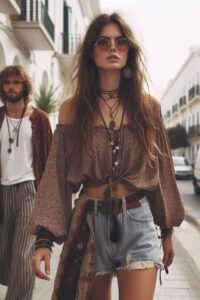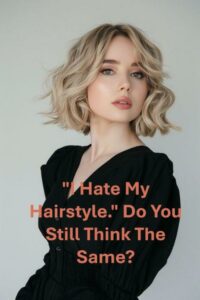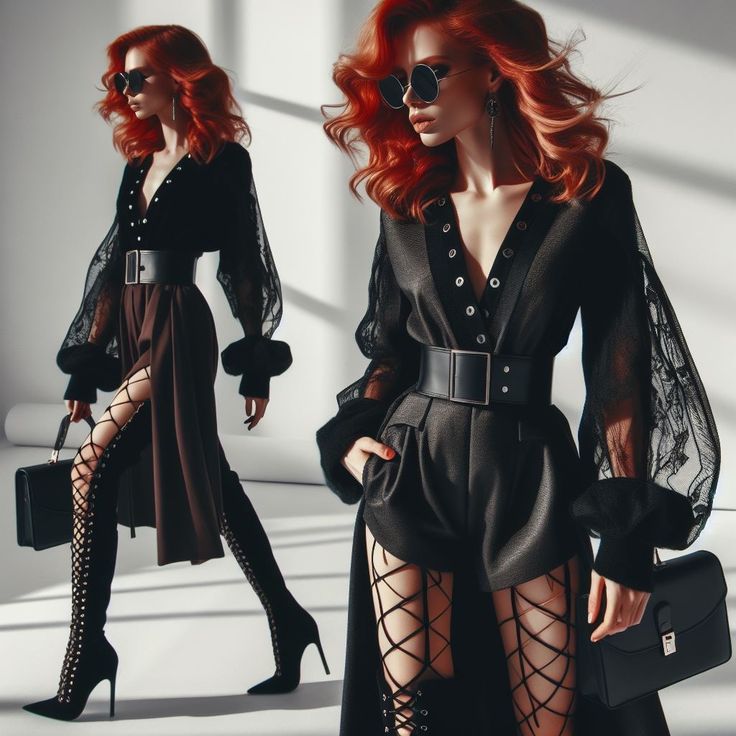
Hey style lovers! Let’s get dark and glamorous—welcome to the world of gothic style. Famous for its drama, mystery and timelessness gothic fashion is so much more than a trend—it’s an attitude, a lifestyle and a way to make a statement. Whether you’re a seasoned goth or just curious about the whole darker look this guide will give you a taste of the beauty of gothic fashion. So put on your lace gloves, dust off your black boots and let’s get into the world of gothic style together!
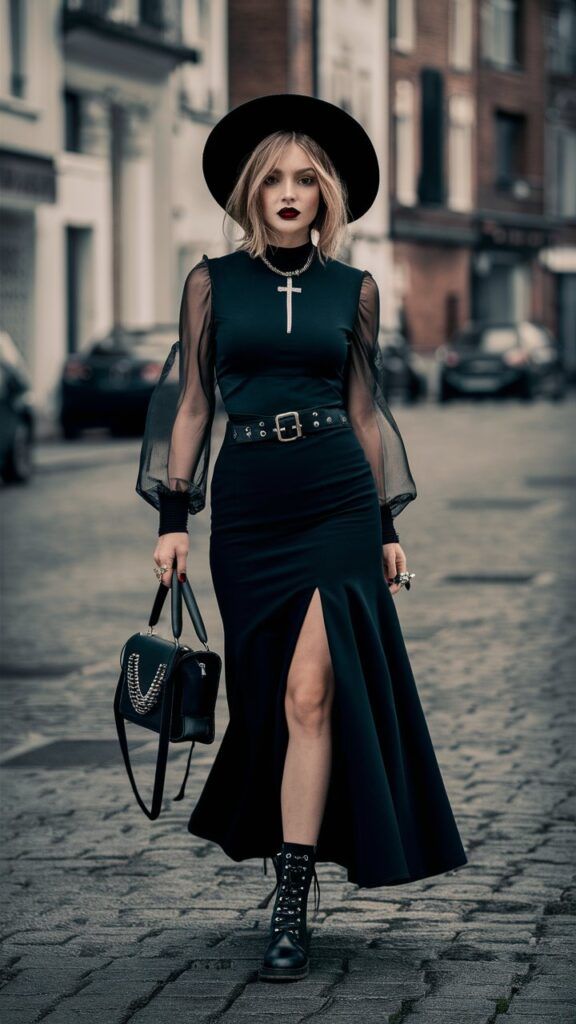
History Of Gothic Fashion Fashion
Gothic fashion is a unique style that combines dark, mysterious elements with elegance and sophistication. The origins of Gothic fashion trace back to various historical and cultural influences. Understanding these roots helps appreciate the depth and richness of this fascinating style.
Historical Influences
Gothic fashion draws heavily from several historical periods. These influences shape the style’s distinctive look. Some key historical elements include:
- Victorian Era: The Victorian era contributes to the romantic and elaborate aspects of Gothic fashion. Think lace, corsets, and long flowing skirts.
- Medieval Period: Medieval clothing, with its rich fabrics and intricate designs, also plays a role. Capes, tunics, and armor-like accessories come from this time.
- Renaissance: The Renaissance era adds a touch of drama and art to Gothic fashion. Puffy sleeves, velvet materials, and detailed embroidery are key features.
These periods provide Gothic fashion with its characteristic mix of darkness and elegance. The result is a style that is both timeless and constantly evolving.
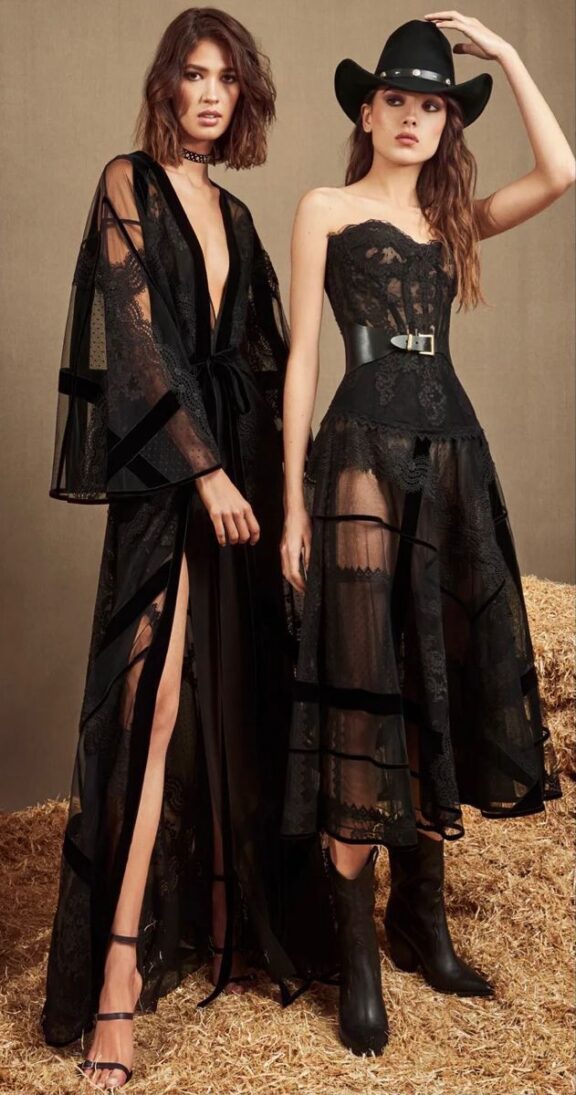
Cultural Roots
Gothic fashion also has deep cultural roots. These influences shape its aesthetic and philosophy. Some significant cultural elements include:
- Gothic Literature: Gothic novels like Mary Shelley’s Frankenstein and Bram Stoker’s Dracula inspire the dark, mysterious themes in Gothic fashion.
- Music: The Goth music scene of the 1980s, with bands like The Cure and Siouxsie and the Banshees, also plays a significant role. The style of these bands influences Gothic fashion heavily.
- Art: Gothic art, with its dark and moody aesthetic, contributes to the visual style of Gothic fashion. This includes everything from medieval paintings to modern Gothic-inspired art.
These cultural roots provide Gothic fashion with its unique identity. They blend history, literature, music, and art into a cohesive and compelling style.
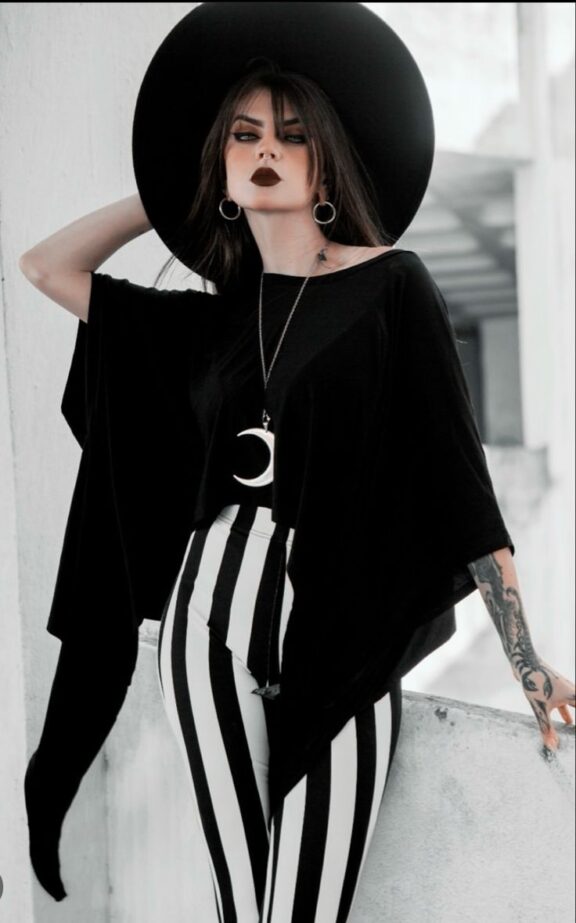
Key Accessories For Gothic Fashion
Gothic fashion is a unique and captivating style that has enthralled many. It is characterized by its dark, mysterious, and often dramatic elements. Understanding the key elements of Gothic fashion can help anyone appreciate and even embody this remarkable style. This section delves into the essential components that make up the Gothic fashion aesthetic.
Also Read: Latest Emo Fashion Ideas-Trend in 2025
Color Palette
The color palette of Gothic fashion is its most distinguishing feature. Black is the predominant color, symbolizing mystery and elegance. This dark hue forms the foundation of Gothic attire.
- Black: The core color, used in almost every Gothic outfit.
- Deep Reds: Adds a touch of drama and passion.
- Rich Purples: Symbolizes royalty and mysticism.
- Dark Blues: Evokes a sense of depth and melancholy.
While black dominates, accent colors like deep reds, purples, and blues add layers of complexity. These colors create a stark contrast against the black, making the ensemble more visually appealing. In certain styles, metallic shades like silver and gold are used to highlight accessories and details, adding a touch of opulence.
 These colors, used in various combinations, form the essence of the Gothic fashion color palette. They help create the dark and mysterious look that defines this style.
These colors, used in various combinations, form the essence of the Gothic fashion color palette. They help create the dark and mysterious look that defines this style.
Fabric Choices
Fabric choices are crucial in Gothic fashion. They contribute significantly to the overall aesthetic. The texture and feel of the fabric can greatly influence the outfit’s mood and appeal.
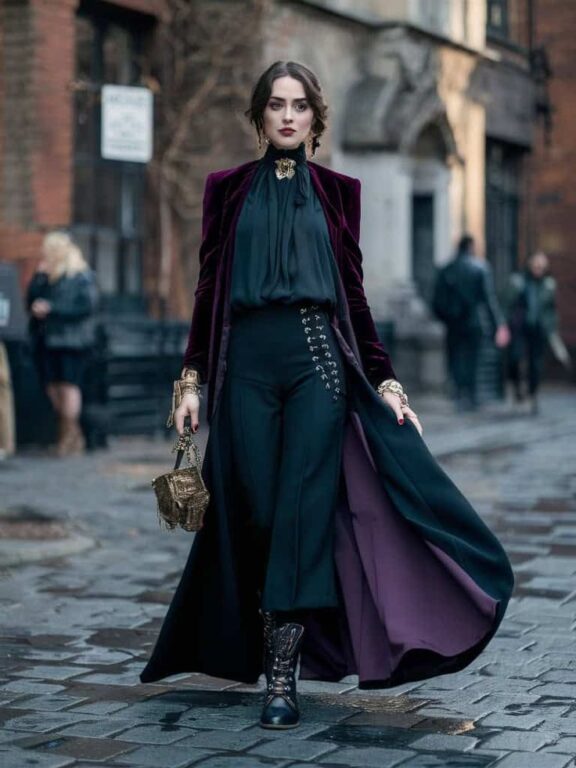
Velvet is a popular choice. It has a luxurious and rich texture, perfect for creating dramatic and elegant outfits. Lace adds a delicate and intricate touch, often used in blouses, dresses, and accessories. Leather offers a more edgy and rebellious vibe, commonly seen in jackets, pants, and corsets.
- Velvet: Luxurious and rich, ideal for dramatic looks.
- Lace: Delicate and intricate, used for detailing.
- Leather: Edgy and rebellious, common in outerwear.
- Cotton: Versatile and breathable, used for everyday wear.
- Satin: Smooth and shiny, perfect for evening wear.
Cotton is versatile and breathable, making it a practical choice for everyday Gothic wear. Satin is smooth and shiny, ideal for evening gowns and special occasions. Each fabric brings its own unique qualities to the table, allowing for a wide range of Gothic styles and expressions.
Read More: Latest African Fashion Dresses Collections| Trendy In 2025|
The right fabric can make or break a Gothic outfit. These fabrics, with their distinct textures and appearances, help create the rich and varied looks that define Gothic fashion.
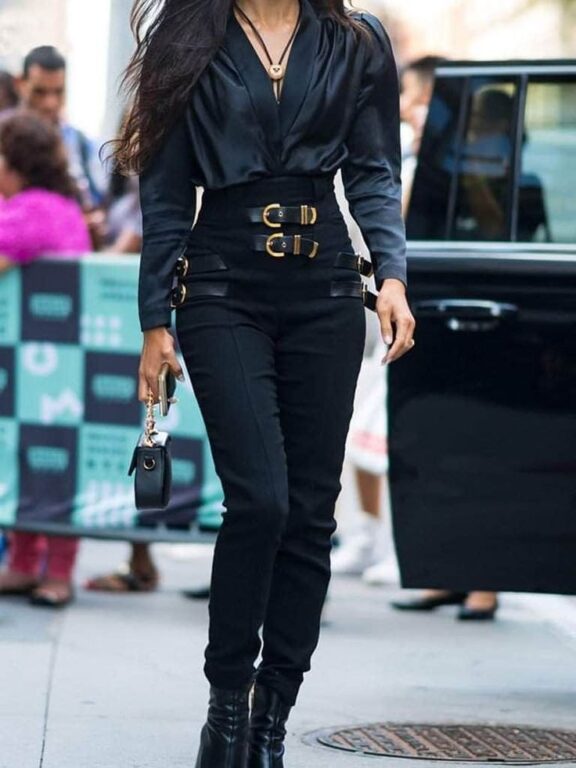
Iconic Styles of Gothic Fashion
Gothic Fashion is a distinct and bold style, rich in history and symbolism. Iconic styles within this fashion genre have evolved over time, blending elements from different eras and movements. These styles are not just about clothing but also about expressing individuality and a deep sense of aesthetics. Let’s dive into some of the most iconic styles in Gothic fashion.
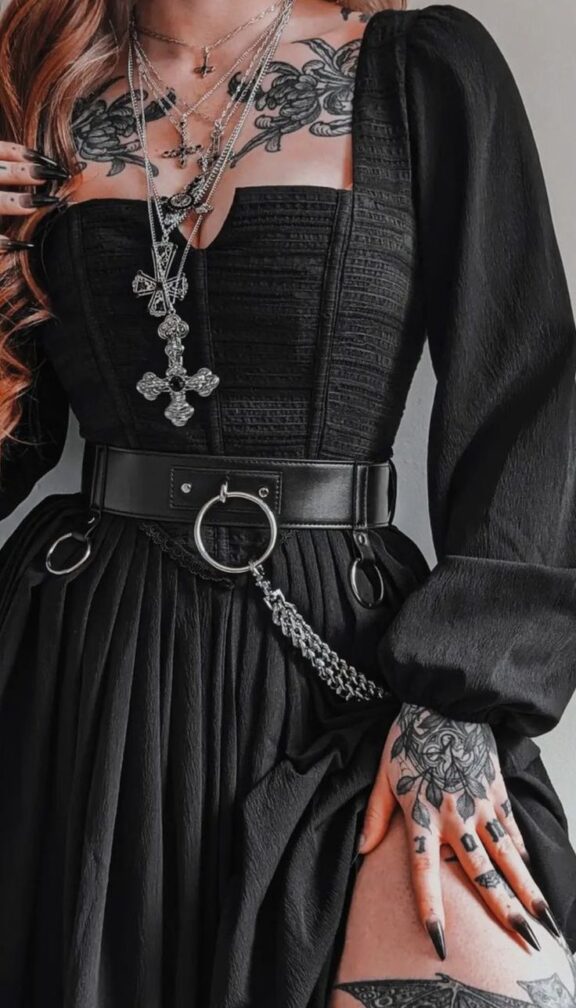
Victorian Influence
The Victorian era has left a significant mark on Gothic fashion. Victorian Gothic is characterized by elaborate and intricate designs. Clothing from this period often includes:
- Corsets: These create an hourglass figure and are often adorned with lace and ribbons.
- Long skirts and dresses: These are usually made from heavy fabrics like velvet and satin.
- High collars: These add a touch of elegance and mystery.
- Lace and frills: These details are crucial in Victorian-inspired outfits.
Accessories play a vital role in Victorian Gothic fashion. Chokers, parasols, and lace gloves are common. These accessories are often in dark colors like black and deep purple.
Makeup in Victorian Gothic fashion is dramatic. Pale skin, dark eyes, and bold lips are common. Hair is often styled in elaborate updos or left long and flowing. The overall look is mysterious, elegant, and timeless.
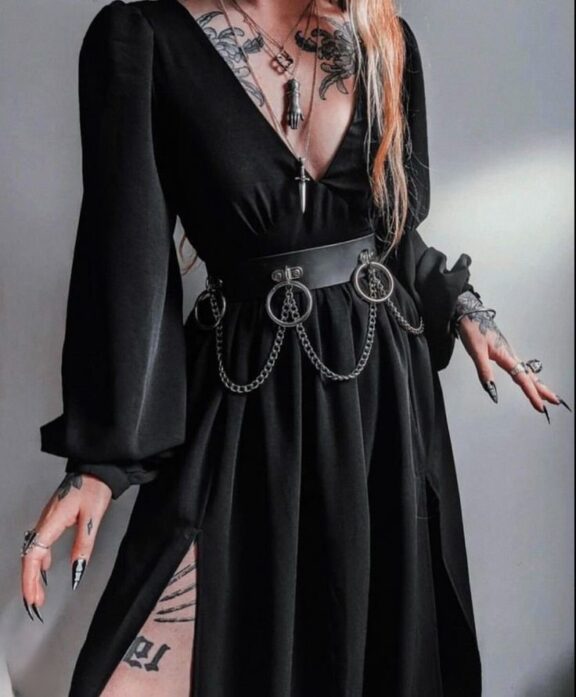
Punk Aesthetics With Gothic Fashion
Punk Gothic combines the rebellious spirit of punk with the dark allure of Gothic fashion. This style is edgy and bold, featuring:
- Leather jackets: Often adorned with spikes, studs, and patches.
- Ripped clothing: Adds a sense of rebellion and non-conformity.
- Combat boots: Essential footwear for a punk Gothic look.
- Fishnet stockings: Adds texture and a daring touch.
Accessories in Punk Gothic are bold and statement-making. Spiked chokers, chains, and oversized belts are popular. These items often have metallic elements to enhance the edgy vibe.
Makeup in Punk Gothic is striking. Dark eyeliner, bold lipstick, and dramatic eyeshadow are common. Hair is often dyed in bold colors like black, deep red, or even bright neon shades. Mohawks, shaved sides, and messy styles are popular. The overall look of Punk Gothic is about expressing individuality and breaking norms. It’s rebellious, bold, and unmistakably unique.
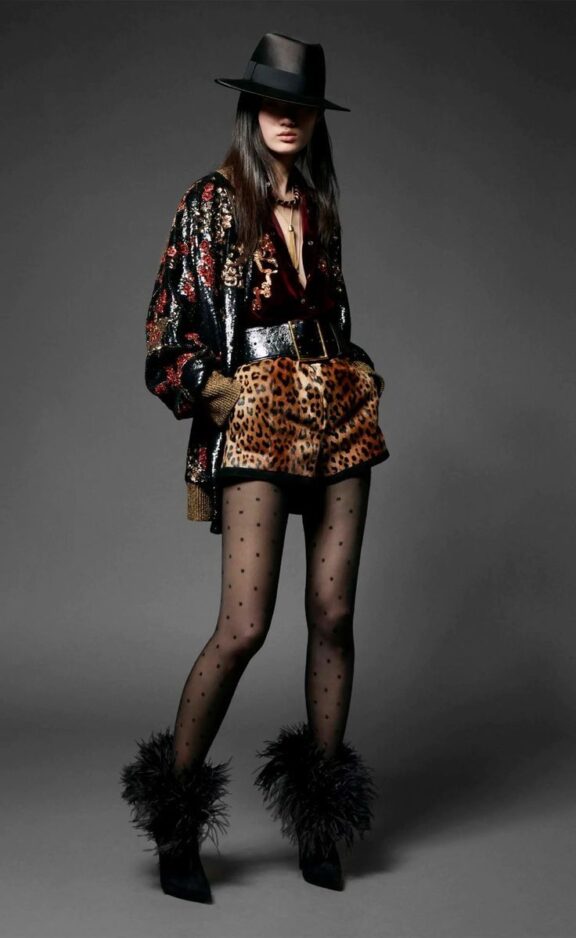
Accessories And Details of Gothic Styling
Gothic fashion is a bold and expressive style that draws inspiration from the dark and mysterious. It is more than just clothing; accessories and details play a crucial role in creating a complete Gothic look. These elements add depth, personality, and a unique touch to any Gothic outfit.
Jewelry Trends
Jewelry is a significant part of Gothic fashion. It often features intricate designs, dark themes, and symbolic elements. Popular materials include silver, blackened metals, and gemstones like onyx, amethyst, and garnet. Here are some trending jewelry pieces:
- Chokers: Often made of velvet, lace, or leather, chokers with pendants or intricate designs are a staple.
- Rings: Large rings with skulls, bats, or gothic symbols add a dramatic flair.
- Bracelets: Cuff bracelets with detailed engravings or studded designs are popular.
- Earrings: Long, dangling earrings with crosses, pentagrams, or gothic motifs are in vogue.
- Pendants: Lockets, cameos, and large pendants with dark stones are sought after.
Popular brands in Gothic jewelry include:
| Brand | Specialty |
|---|---|
| Alchemy Gothic | Intricate designs with symbolic elements |
| Restyle | Dark and mysterious motifs |
| Killstar | Modern gothic aesthetics |
Gothic Footwear Styles
Footwear in Gothic fashion is just as important as the clothing and accessories. Boots are particularly popular and come in various styles to suit different gothic looks. Here are some common footwear styles:
- Combat Boots: Sturdy, with thick soles and lace-up designs. These boots often feature buckles and metal accents.
- Platform Boots: Known for their high, chunky soles, platform boots add height and drama to any outfit.
- Victorian Boots: Elegant and often made of leather or velvet, these boots feature lace-up fronts and intricate detailing.
- Witch Boots: Pointed toes and lace-up designs give these boots a mystical appearance.
- Gothic Sneakers: For a casual look, gothic sneakers with dark colors and unique designs are a good choice.
Key characteristics to look for in Gothic footwear:
- Material: Leather, velvet, and synthetic materials are common.
- Color: Black is the dominant color, but dark reds and purples are also popular.
- Details: Look for buckles, laces, and metal accents to add a gothic touch.
Popular brands in Gothic footwear include:
| Brand | Specialty |
|---|---|
| New Rock | High-quality, durable boots with gothic designs |
| Demonia | Edgy and alternative footwear styles |
| Dr. Martens | Classic combat boots with a gothic twist |
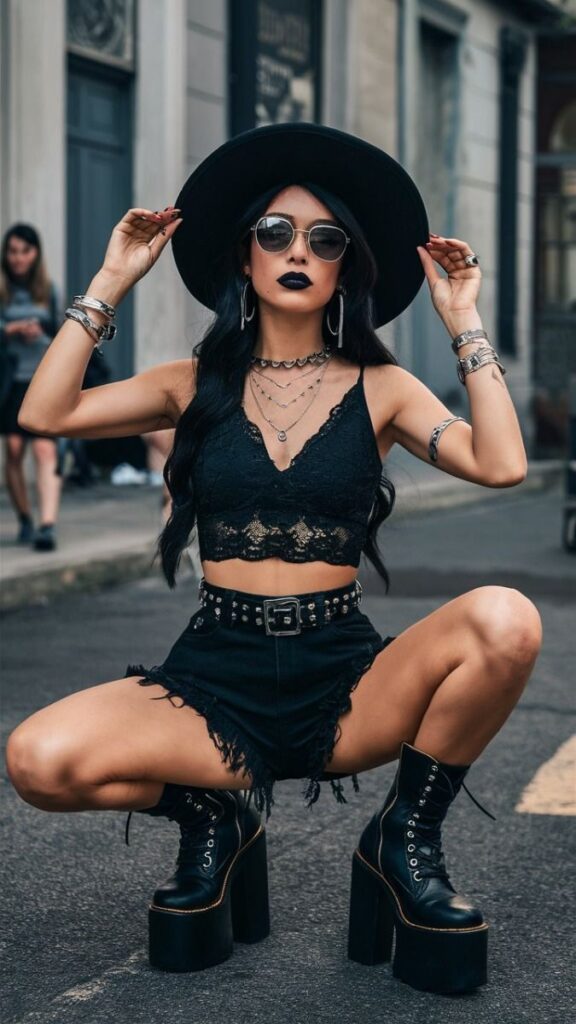
Gothic Subcultures
Gothic fashion isn’t just one style; it’s a collection of many unique subcultures. Each subculture offers a distinct look and feel, reflecting different aspects of the goth lifestyle. Whether you’re drawn to the elegance of Romantic Goth or the futuristic vibes of Cyber Goth, there’s something in gothic fashion for everyone.
Romantic Goth
Romantic Goth is all about elegance, drama, and romance. This subculture draws inspiration from the Victorian era, featuring a lot of lace, velvet, and flowing fabrics. It emphasizes a soft, yet dark aesthetic, often incorporating historical elements.
Some key characteristics include:
- Lace and Velvet: These materials are a staple in Romantic Goth fashion.
- Flowing Fabrics: Long skirts and billowy sleeves are common.
- Dark Colors: Black is predominant, but deep reds and purples are also popular.
Accessories play a huge role in achieving the Romantic Goth look. Think of ornate jewelry, chokers, and cameo brooches. Hair is usually styled in elaborate updos or long, flowing waves.
Cyber Goth
Cyber Goth is a fusion of goth and rave culture. It features neon colors, futuristic elements, and industrial vibes. This subculture is highly influenced by science fiction and cyberpunk aesthetics.
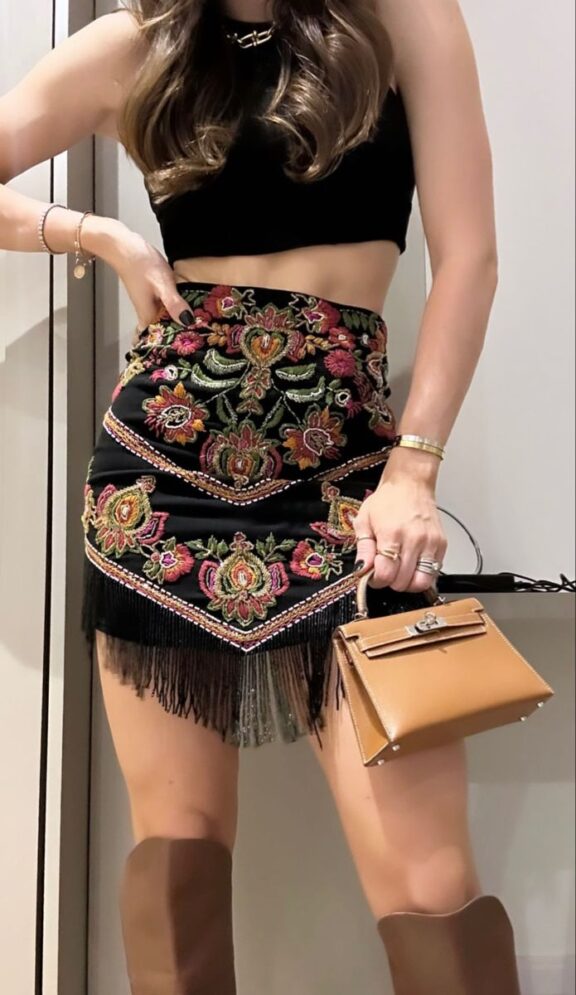
Key characteristics include:
- Neon Colors: Bright greens, pinks, and blues are common.
- Futuristic Fabrics: PVC, latex, and mesh are popular choices.
- Tech Accessories: Goggles, respirators, and LED lights add a techy feel.
Cyber Goths often wear platform boots and tight-fitting clothing. Hair is usually styled in brightly colored dreadlocks or synthetic hair extensions, often called cyberlox.
How To Do Modern Styling With Gothic Fashion
Gothic fashion has always been known for its dark, mysterious, and romantic appeal. Over the years, it has evolved, blending with contemporary styles. This blend has given rise to fascinating modern interpretations of Gothic fashion. These interpretations keep the core elements intact while adding a fresh twist.
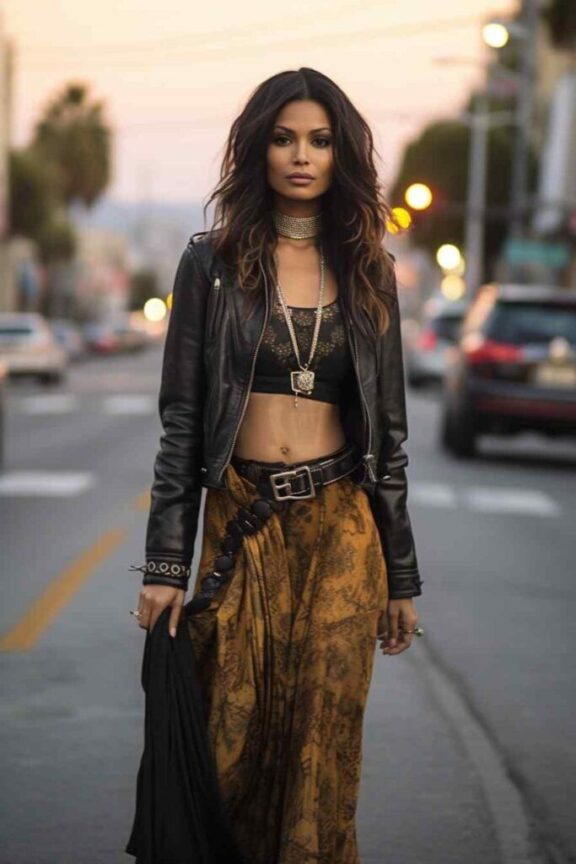
Gothic Street Fashion
Street fashion offers a practical yet stylish take on Gothic fashion. The modern Gothic street style combines traditional Gothic elements with everyday wear. This makes it accessible and versatile. Key components of Gothic street fashion include:
- Black clothing: Black remains the dominant color.
- Leather jackets: A staple for a rugged, edgy look.
- Ripped jeans: Adds a casual yet rebellious touch.
- Combat boots: Perfect for comfort and style.
- Layering: Combining different textures and fabrics.
Accessories play a crucial role in Gothic street fashion:
- Chokers: Often adorned with spikes or lace.
- Silver jewelry: Rings, bracelets, and necklaces.
- Studded belts: Adds an extra edge to any outfit.
- Dark makeup: Black eyeliner and lipstick.
A typical Gothic street outfit might include a black leather jacket, ripped jeans, and combat boots. Add a choker necklace and dark makeup to complete the look.
Gothic Runway Trends
The runway showcases Gothic fashion in a more extravagant and artistic manner. Designers draw inspiration from Gothic themes, creating bold and innovative pieces. Current Gothic runway trends feature:
- Victorian-inspired gowns: Featuring lace, ruffles, and corsets.
- High collars: Adding a dramatic flair.
- Velvet fabrics: Rich and luxurious textures.
- Intricate embroidery: Often depicting dark and mystical themes.
- Sheer fabrics: Adding a sense of mystery and allure.
Runway Gothic fashion often incorporates elaborate details:
- Feather accents: Used in dresses and accessories.
- Metal embellishments: Chains, studs, and spikes.
- Oversized hats: Dramatic and eye-catching.
- Platform boots: Adding height and presence.
Designers like Alexander McQueen and Givenchy are known for their Gothic-inspired collections. Their runway shows often feature dark, theatrical themes and exquisite craftsmanship.
DIY Gothic Fashion Idea For 2025
Gothic fashion is known for its dark, mysterious, and romantic elements. DIY Gothic fashion allows you to express your unique style while saving money. By creating your own pieces, you can ensure that your wardrobe is truly one-of-a-kind. Explore ways to upcycle and customize your clothes to fit your Gothic aesthetic perfectly.
Upcycling Ideas
Upcycling is a great way to transform old clothes into Gothic masterpieces. You can give new life to items that you already own. Here are some creative upcycling ideas:
- Dyeing: Turn light-colored clothes into dark, moody pieces by using black or deep purple dye.
- Adding Lace: Sew lace trim onto sleeves, hems, or necklines. Lace adds a vintage Gothic touch.
- Studs and Spikes: Attach metal studs and spikes to jackets, boots, and bags. This gives a punk-Gothic edge.
- Patchwork: Combine different fabrics and textures. Use velvet, leather, and lace patches to create a unique garment.
Customization Tips For Gothic Style
Customization allows you to add personal touches to your Gothic outfits. Simple changes can make a big difference. Consider these tips:
- Embellishments: Add chains, charms, and brooches. These small items can create a striking look.
- Distressing: Tear and fray edges of jeans and shirts. Distressed clothing looks more authentic and worn.
- Embroidery: Stitch Gothic symbols like skulls, bats, or crosses onto your clothes. Embroidery adds a unique flair.
- Painting: Use fabric paint to create Gothic designs. Patterns like spider webs or baroque motifs stand out.
Here are some ideas for customization:
- Boots: Paint them black and add chains or studs.
- Hats: Decorate with feathers, lace, or veils.
- Belts: Attach charms or small fabric patches.
- Gloves: Cut off the fingers and add lace or leather strips.
Experimenting with these tips will help you create a wardrobe that reflects your Gothic style. Each piece will tell its own story.
Gothic Influence On Pop Culture
Gothic Fashion has always fascinated with its dark, mysterious allure. Over the years, its influence on pop culture has been profound. From film to music and literature, Gothic elements have left an indelible mark. This blog post explores how Gothic Fashion has permeated various aspects of pop culture, captivating audiences worldwide.
Film And Music
Gothic Fashion has significantly influenced both film and music. In movies, characters often wear Gothic-inspired outfits to convey a sense of mystery and darkness. Tim Burton’s films are a prime example. His characters often sport Gothic attire, creating a unique aesthetic that is both eerie and enchanting.
In the music industry, Gothic Fashion has made a substantial impact. Bands like The Cure and Bauhaus have popularized Gothic looks. Their dark clothing, heavy makeup, and somber tones resonate with fans. Marilyn Manson is another iconic figure. His Gothic-inspired outfits and theatrical performances have captivated audiences for decades. In music videos, Gothic Fashion often sets the tone. Artists use dark, elaborate costumes to enhance their storytelling. This blend of fashion and music creates a mesmerizing experience for the audience.
Literature References
Gothic Fashion also finds its roots in literature. Classic Gothic novels have influenced modern fashion trends. Mary Shelley’s Frankenstein and Bram Stoker’s Dracula are seminal works that have shaped Gothic aesthetics. These novels often describe characters in dark, elaborate clothing, setting a somber tone. Edgar Allan Poe’s works further popularized Gothic elements. His characters frequently wear black, enhancing their mysterious aura. Here are some key Gothic literature works and their fashion influences:
- Frankenstein: Dark, Victorian-era clothing, intricate details
- Dracula: Elegant, yet dark attire, capes, and high collars
- Poe’s Tales: Black clothing, melancholic accessories
Modern authors continue to draw inspiration from these classics. Anne Rice’s Vampire Chronicles feature characters in Gothic attire. This trend keeps the Gothic fashion spirit alive in contemporary literature. Gothic Fashion’s presence in literature enhances the reading experience. It adds depth to characters and settings. This enduring influence ensures that Gothic Fashion remains a vital part of pop culture.
Frequently Asked Questions
What Is Gothic Fashion?
Gothic fashion is a style marked by dark, mysterious, and antiquated elements. It often features black clothing, lace, and Victorian-inspired details. Accessories like chokers and dark makeup are common.
How Did Gothic Fashion Start?
Gothic fashion emerged in the early 1980s. It evolved from the Gothic rock scene. Influences include Victorian and punk styles.
What Are Common Gothic Fashion Elements?
Common Gothic fashion elements include black clothing, lace, and corsets. Accessories like chokers and dark makeup are also popular. Victorian and punk influences are often seen.
Where Can I Buy Gothic Clothing?
You can buy Gothic clothing from specialized online stores. Some mainstream retailers also carry Gothic-inspired items. Thrift stores may have unique pieces.
Conclusion
Gothic fashion offers a unique way to express individuality. Its rich history and distinct style continue to inspire. Embrace the dark elegance and make it your own. Whether through clothing, accessories, or makeup, there’s a gothic touch for everyone. Dive into this captivating world and let your creativity shine.


